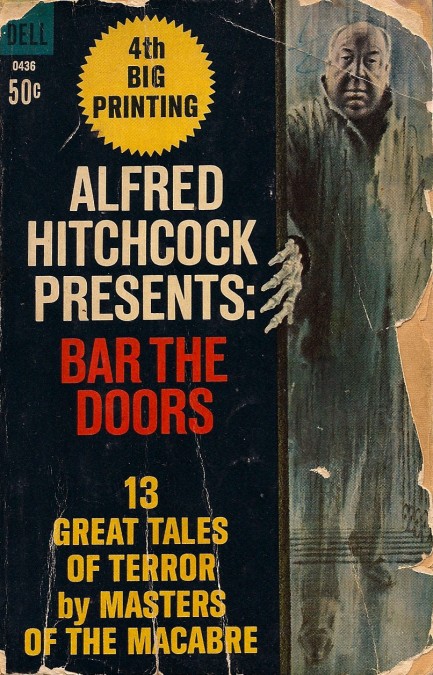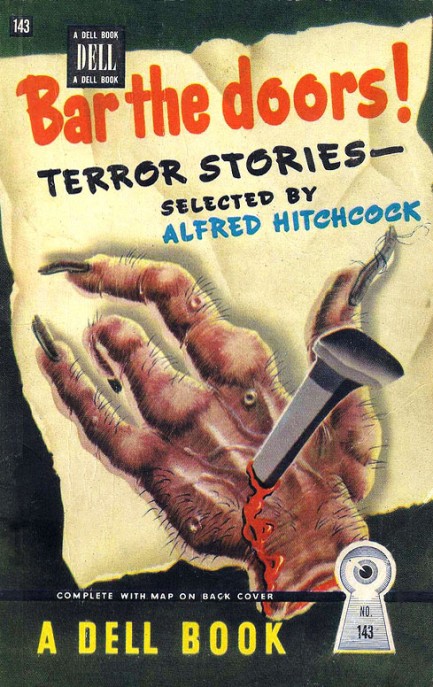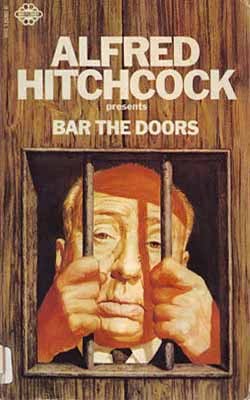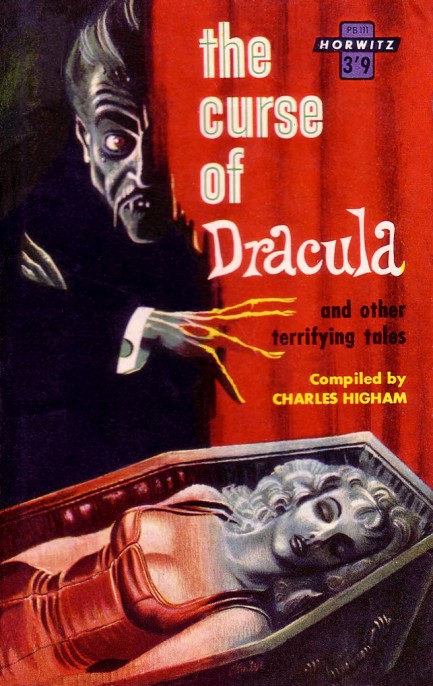 Hitchcock presents thirteen excellent tales of terror. 
Alfred Hitchcock Presents: Bar the Doors contains some of the best macabre fiction we’ve ever read. The collection begins with H.G. Wells’ violent, oppressive tale of murder and voodoo in Sierra Leone “Pollock and the Porroh Man.” The story was written in 1895 and comes with the sort of classical styling you might expect, but with a surprisingly modern pacing as the first paragraph finds the lead character caught in the middle of a stabbing. Pollock pulls a gun to defend himself and the Porroh Man flees, but not before casting an infuriated gaze back that promises revenge. Little does Pollock know that revenge can take supernatural form. You’d expect the tale to be laced with racism, and it is—this line from the first paragraph is simply amazing: “At any rate, the Porroh Man stabbed the woman through the heart as though he had been a mere low class Italian.” African characters fare far worse. However in this context of mortal struggle between a voodoo conjurer and a self-entitled Englishman, racism comes off as impotence against overwhelming powers.   “Pollock and the Porroh Man” was written four years before Joseph Conrad’s “Heart of Darkness.” Conrad’s work is a novella-length masterpiece, whereas Wells’ story is under ten pages, but Wells is quite successful at exploring a different heart of darkness by bringing to life the deepest colonial fear, the one chortling, brandy-swilling men laugh at as long as they’re in a well lit room bolstered by their own numbers—the fear that munitions and cruelty will suffice to maintain control only insofar as natives aren’t pushed too far. But when that day comes, when native peoples have had enough, then colonials will find that voodoo and magic are real, that technology is truly the illusion, and bloody payment is due for crimes committed against people that wanted only to be left alone. “Pollock and the Porroh Man” was written four years before Joseph Conrad’s “Heart of Darkness.” Conrad’s work is a novella-length masterpiece, whereas Wells’ story is under ten pages, but Wells is quite successful at exploring a different heart of darkness by bringing to life the deepest colonial fear, the one chortling, brandy-swilling men laugh at as long as they’re in a well lit room bolstered by their own numbers—the fear that munitions and cruelty will suffice to maintain control only insofar as natives aren’t pushed too far. But when that day comes, when native peoples have had enough, then colonials will find that voodoo and magic are real, that technology is truly the illusion, and bloody payment is due for crimes committed against people that wanted only to be left alone. There are other great stories in the collection—F. Marion Crawford’s “The Upper Berth” tells the tale of a man who has an unwanted supernatural visitor in his stateroom every night; Alfred Noyes’ “Midnight Express” preys on readers’ classic misgivings about deserted tube platforms; Ambrose Bierce’s “The Damned Thing” tackles the Lovecraftian theme of an other-dimensional beast that cannot be seen; and McKnight Malmar’s “The Storm” might be of interest to those who just experienced last night’s thunderous downpours in Great Britain. In fact, the entire collection is stormy night reading. It was first published in 1946 and reprinted numerous times, as the alternate covers above reveals. Highly recommended.
 Pay no attention to the fiend behind the curtain. 
Above is an absolutely vibrant cover for Charles Higham’s vampire anthology The Curse of Dracula and Other Terrifying Tales, published by the Aussie imprint Horwitz in 1962. Inside you get six stories by Theophile Gautier, H.T.W. Bousfield, Ambrose Bierce, E. Nesbit, Honoré de Balzac, and that one guy, er, what’s his name? Ah! Bram Stoker. The cover artist was Frank Benier, who was Australian by birth but Basque by ancestry and saw his first piece published when he was but fourteen. Apparently, he was primarily a cartoonist, but this is a top tier pulp painting he’s put together here. Hopefully we’ll run across more of his work down the line.
 Chestnuts roasting by an open fire. 
After a few weeks of uncharacteristically normal models, the guys from Goodtime Weekly get back to business as usual with a photo from Ron Vogel and model who is—there’s no other phrase—enormously endowed. Autumn is here, after all, so perhaps she symbolizes the stockpiling of food for winter, the horn of plenty filled with inexhaustible gifts, the warmth sought on cold nights. Or maybe they just liked big boobs. Anyway, we said last week we’d try a few of the Goodtime quips in the real world, and, “Ahhh!” Ahhh haaah!” was usually the reaction. Or, “That’s, um—where did you hear that?” But a few went over well. So experiment inconclusive. We’ll continue testing during the next couple of weeks, because the American expat clique has a few Halloween related social gatherings coming up. When we’re done with this experiment we will know definitively whether Goodtime Weekly humor is timeless, or should simply be forgotten. Oct 20: “Mother-in-law: A woman who arranged a match for her daughter and then intends to referee as well.”—Pat Buttram Oct 21: “Bar bells are sometimes easier to pick up than bar bills.”—Sam Cowling Oct 22: “The wife of an archaeologist says, ‘The older I get the better I look to my husband.’”—Phyllis Diller Oct 23: “A bore is a person who talks when you wish him to listen.”—Ambrose Bierce Oct 24: Cars are not the only things that can hit and run a man down; gossipers have done worse. Oct 25: “A perfect husband is one who can understand every word his wife isn’t saying.”—Sig Sakowicz Oct 26: “Some wives cause happiness wherever they go; others whenever they go,”—Freddie Flintstone
|
 |

The headlines that mattered yesteryear.
1945—Churchill Given the Sack
In spite of admiring Winston Churchill as a great wartime leader, Britons elect
Clement Attlee the nation's new prime minister in a sweeping victory for the Labour Party over the Conservatives. 1952—Evita Peron Dies
Eva Duarte de Peron, aka Evita, wife of the president of the Argentine Republic, dies from cancer at age 33. Evita had brought the working classes into a position of political power never witnessed before, but was hated by the nation's powerful military class. She is lain to rest in Milan, Italy in a secret grave under a nun's name, but is eventually returned to Argentina for reburial beside her husband in 1974. 1943—Mussolini Calls It Quits
Italian dictator Benito Mussolini steps down as head of the armed forces and the government. It soon becomes clear that Il Duce did not relinquish power voluntarily, but was forced to resign after former Fascist colleagues turned against him. He is later installed by Germany as leader of the Italian Social Republic in the north of the country, but is killed by partisans in 1945. 1915—Ship Capsizes on Lake Michigan
During an outing arranged by Western Electric Co. for its employees and their families, the passenger ship Eastland capsizes in Lake Michigan due to unequal weight distribution. 844 people die, including all the members of 22 different families. 1980—Peter Sellers Dies
British movie star Peter Sellers, whose roles in Dr. Strangelove, Being There and the Pink Panther films established him as the greatest comedic actor of his generation, dies of a heart attack at age fifty-four.
|

|
|

It's easy. We have an uploader that makes it a snap. Use it to submit your art, text, header, and subhead. Your post can be funny, serious, or anything in between, as long as it's vintage pulp. You'll get a byline and experience the fleeting pride of free authorship. We'll edit your post for typos, but the rest is up to you. Click here to give us your best shot.

|
|



 “Pollock and the Porroh Man” was written four years before Joseph Conrad’s “Heart of Darkness.” Conrad’s work is a novella-length masterpiece, whereas Wells’ story is under ten pages, but Wells is quite successful at exploring a different heart of darkness by bringing to life the deepest colonial fear, the one chortling, brandy-swilling men laugh at as long as they’re in a well lit room bolstered by their own numbers—the fear that munitions and cruelty will suffice to maintain control only insofar as natives aren’t pushed too far. But when that day comes, when native peoples have had enough, then colonials will find that voodoo and magic are real, that technology is truly the illusion, and bloody payment is due for crimes committed against people that wanted only to be left alone.
“Pollock and the Porroh Man” was written four years before Joseph Conrad’s “Heart of Darkness.” Conrad’s work is a novella-length masterpiece, whereas Wells’ story is under ten pages, but Wells is quite successful at exploring a different heart of darkness by bringing to life the deepest colonial fear, the one chortling, brandy-swilling men laugh at as long as they’re in a well lit room bolstered by their own numbers—the fear that munitions and cruelty will suffice to maintain control only insofar as natives aren’t pushed too far. But when that day comes, when native peoples have had enough, then colonials will find that voodoo and magic are real, that technology is truly the illusion, and bloody payment is due for crimes committed against people that wanted only to be left alone.







































































